BSBMGT615 Contribute to Organisation Development: Detailed Report
VerifiedAdded on 2023/04/21
|19
|3901
|148
Report
AI Summary
This report outlines a plan for organizational changes and development within ABC International PTY Ltd, addressing competitive pressures and executive departures. The plan involves four teams focusing on strategic requirements, stakeholder management, implementation planning, and cost-benefit analysis. It aims to enhance market share, revenue, and technological infrastructure. The report also explores organizational development from the perspective of drastic action versus evolutionary adaptation, linking these approaches to Theory E and Theory O, respectively. It discusses the application of change management models like Kurt Lewin’s model and motivational theories like Herzberg’s two-factor theory to facilitate effective organizational change.
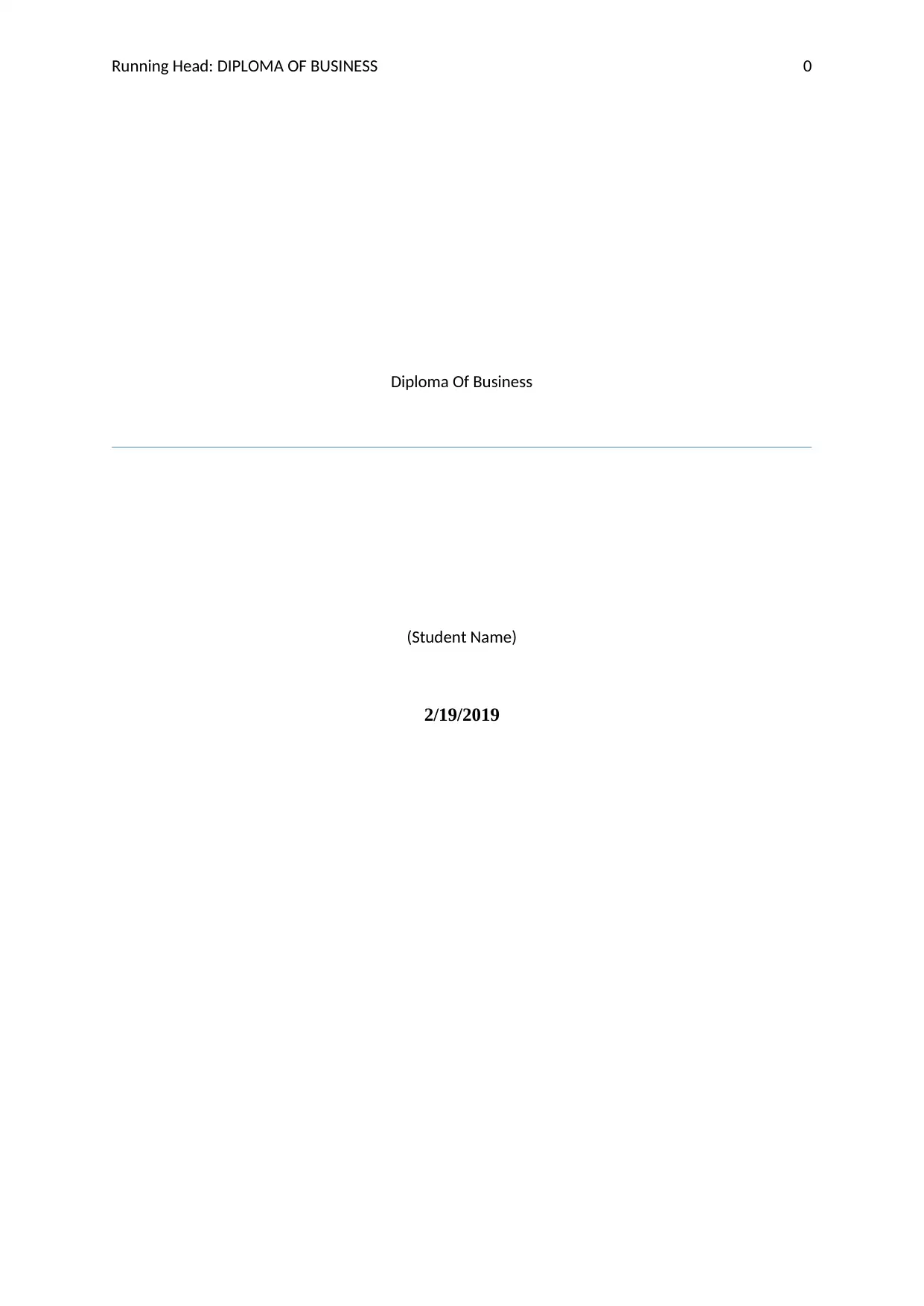
Running Head: DIPLOMA OF BUSINESS 0
Diploma Of Business
(Student Name)
2/19/2019
Diploma Of Business
(Student Name)
2/19/2019
Paraphrase This Document
Need a fresh take? Get an instant paraphrase of this document with our AI Paraphraser
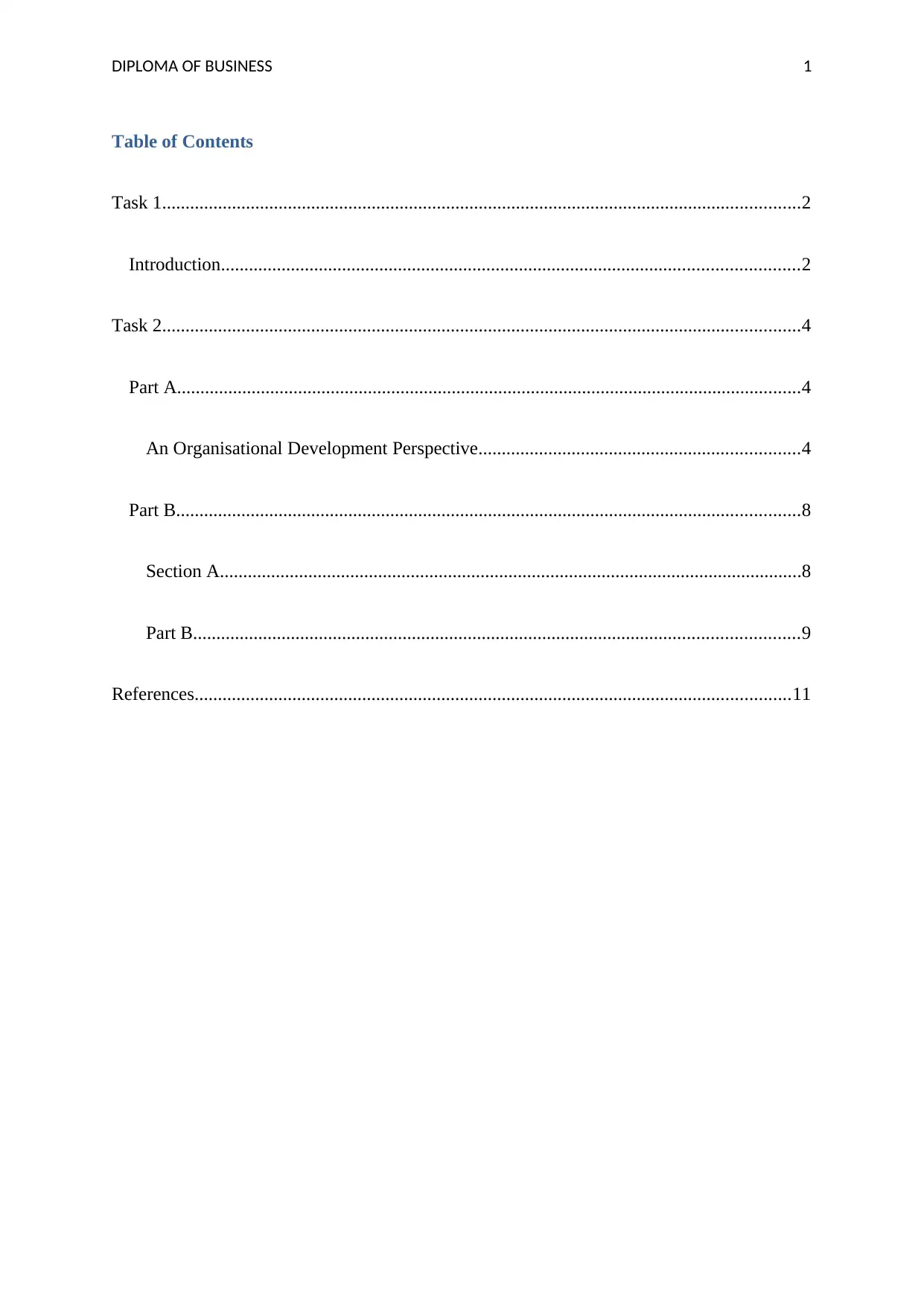
DIPLOMA OF BUSINESS 1
Table of Contents
Task 1.........................................................................................................................................2
Introduction............................................................................................................................2
Task 2.........................................................................................................................................4
Part A......................................................................................................................................4
An Organisational Development Perspective.....................................................................4
Part B......................................................................................................................................8
Section A.............................................................................................................................8
Part B..................................................................................................................................9
References................................................................................................................................11
Table of Contents
Task 1.........................................................................................................................................2
Introduction............................................................................................................................2
Task 2.........................................................................................................................................4
Part A......................................................................................................................................4
An Organisational Development Perspective.....................................................................4
Part B......................................................................................................................................8
Section A.............................................................................................................................8
Part B..................................................................................................................................9
References................................................................................................................................11
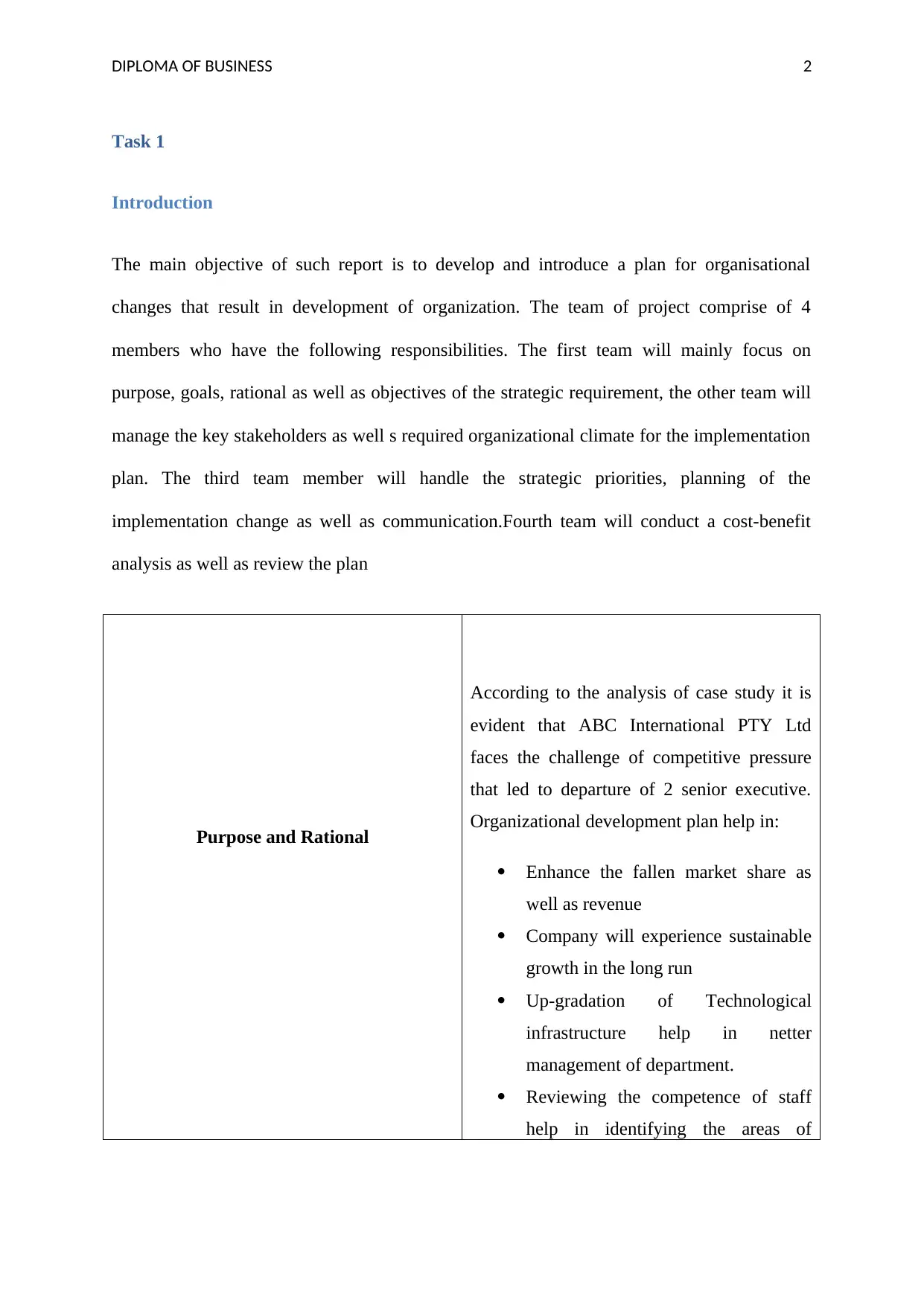
DIPLOMA OF BUSINESS 2
Task 1
Introduction
The main objective of such report is to develop and introduce a plan for organisational
changes that result in development of organization. The team of project comprise of 4
members who have the following responsibilities. The first team will mainly focus on
purpose, goals, rational as well as objectives of the strategic requirement, the other team will
manage the key stakeholders as well s required organizational climate for the implementation
plan. The third team member will handle the strategic priorities, planning of the
implementation change as well as communication.Fourth team will conduct a cost-benefit
analysis as well as review the plan
Purpose and Rational
According to the analysis of case study it is
evident that ABC International PTY Ltd
faces the challenge of competitive pressure
that led to departure of 2 senior executive.
Organizational development plan help in:
Enhance the fallen market share as
well as revenue
Company will experience sustainable
growth in the long run
Up-gradation of Technological
infrastructure help in netter
management of department.
Reviewing the competence of staff
help in identifying the areas of
Task 1
Introduction
The main objective of such report is to develop and introduce a plan for organisational
changes that result in development of organization. The team of project comprise of 4
members who have the following responsibilities. The first team will mainly focus on
purpose, goals, rational as well as objectives of the strategic requirement, the other team will
manage the key stakeholders as well s required organizational climate for the implementation
plan. The third team member will handle the strategic priorities, planning of the
implementation change as well as communication.Fourth team will conduct a cost-benefit
analysis as well as review the plan
Purpose and Rational
According to the analysis of case study it is
evident that ABC International PTY Ltd
faces the challenge of competitive pressure
that led to departure of 2 senior executive.
Organizational development plan help in:
Enhance the fallen market share as
well as revenue
Company will experience sustainable
growth in the long run
Up-gradation of Technological
infrastructure help in netter
management of department.
Reviewing the competence of staff
help in identifying the areas of
⊘ This is a preview!⊘
Do you want full access?
Subscribe today to unlock all pages.

Trusted by 1+ million students worldwide
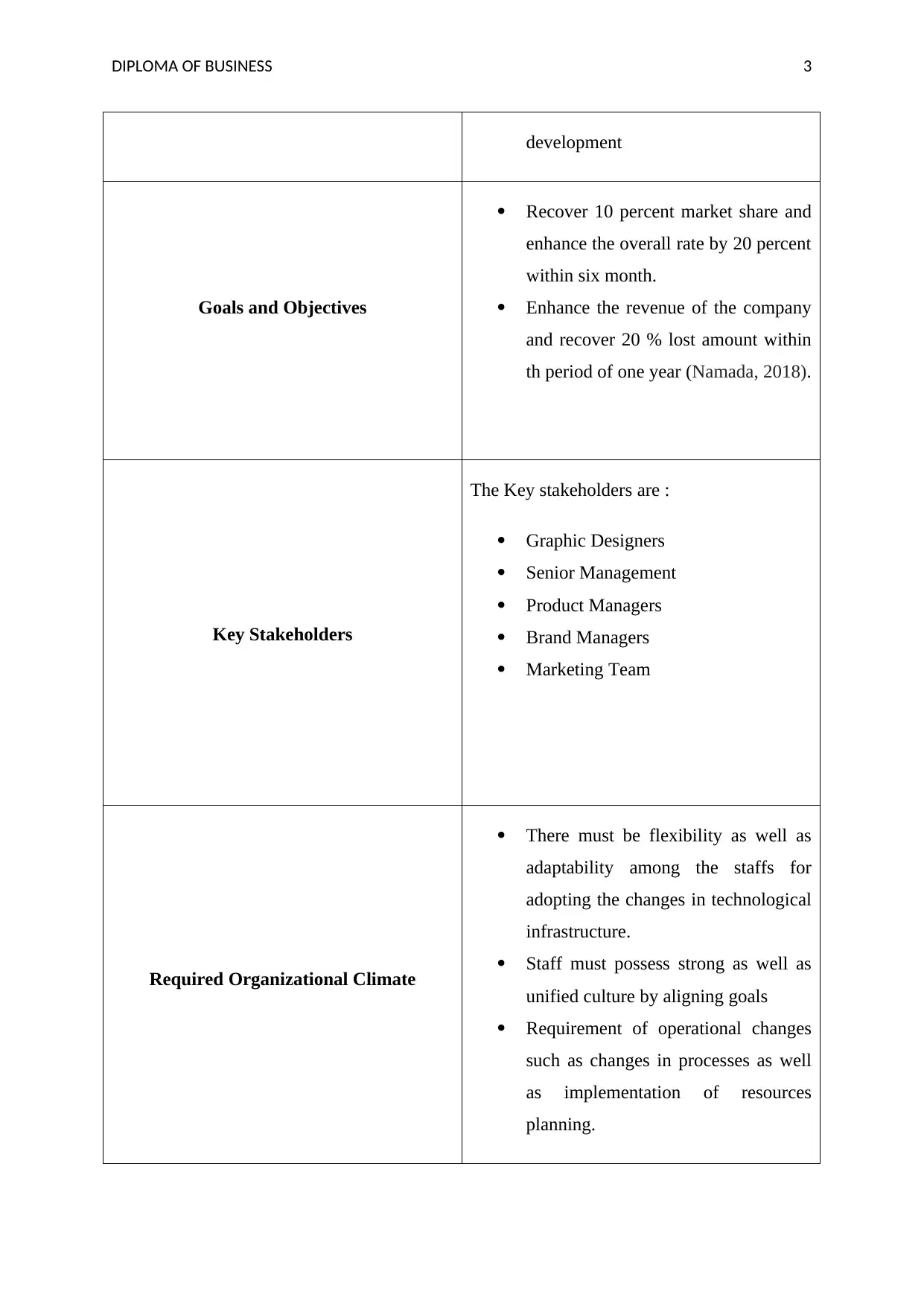
DIPLOMA OF BUSINESS 3
development
Goals and Objectives
Recover 10 percent market share and
enhance the overall rate by 20 percent
within six month.
Enhance the revenue of the company
and recover 20 % lost amount within
th period of one year (Namada, 2018).
Key Stakeholders
The Key stakeholders are :
Graphic Designers
Senior Management
Product Managers
Brand Managers
Marketing Team
Required Organizational Climate
There must be flexibility as well as
adaptability among the staffs for
adopting the changes in technological
infrastructure.
Staff must possess strong as well as
unified culture by aligning goals
Requirement of operational changes
such as changes in processes as well
as implementation of resources
planning.
development
Goals and Objectives
Recover 10 percent market share and
enhance the overall rate by 20 percent
within six month.
Enhance the revenue of the company
and recover 20 % lost amount within
th period of one year (Namada, 2018).
Key Stakeholders
The Key stakeholders are :
Graphic Designers
Senior Management
Product Managers
Brand Managers
Marketing Team
Required Organizational Climate
There must be flexibility as well as
adaptability among the staffs for
adopting the changes in technological
infrastructure.
Staff must possess strong as well as
unified culture by aligning goals
Requirement of operational changes
such as changes in processes as well
as implementation of resources
planning.
Paraphrase This Document
Need a fresh take? Get an instant paraphrase of this document with our AI Paraphraser
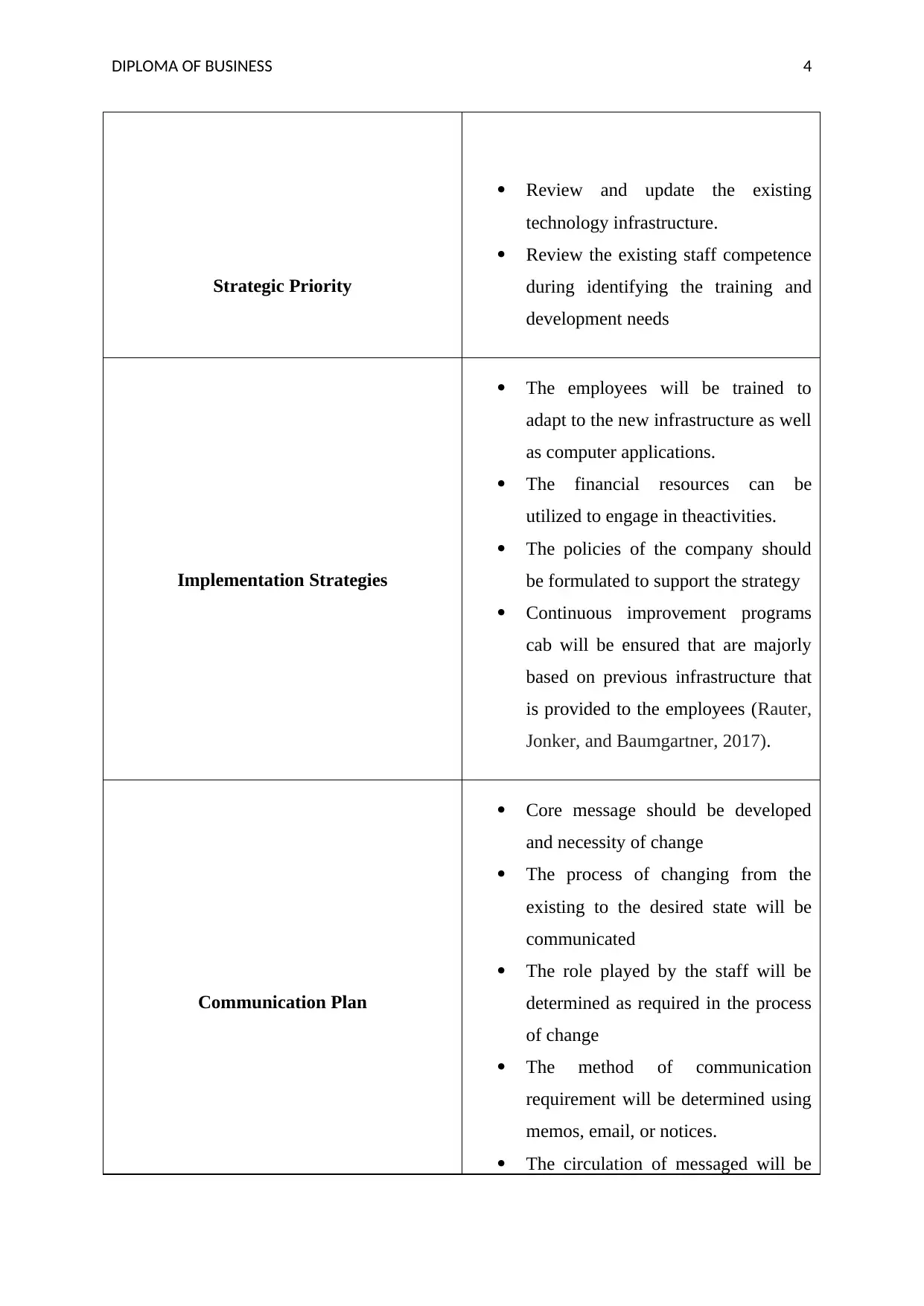
DIPLOMA OF BUSINESS 4
Strategic Priority
Review and update the existing
technology infrastructure.
Review the existing staff competence
during identifying the training and
development needs
Implementation Strategies
The employees will be trained to
adapt to the new infrastructure as well
as computer applications.
The financial resources can be
utilized to engage in theactivities.
The policies of the company should
be formulated to support the strategy
Continuous improvement programs
cab will be ensured that are majorly
based on previous infrastructure that
is provided to the employees (Rauter,
Jonker, and Baumgartner, 2017).
Communication Plan
Core message should be developed
and necessity of change
The process of changing from the
existing to the desired state will be
communicated
The role played by the staff will be
determined as required in the process
of change
The method of communication
requirement will be determined using
memos, email, or notices.
The circulation of messaged will be
Strategic Priority
Review and update the existing
technology infrastructure.
Review the existing staff competence
during identifying the training and
development needs
Implementation Strategies
The employees will be trained to
adapt to the new infrastructure as well
as computer applications.
The financial resources can be
utilized to engage in theactivities.
The policies of the company should
be formulated to support the strategy
Continuous improvement programs
cab will be ensured that are majorly
based on previous infrastructure that
is provided to the employees (Rauter,
Jonker, and Baumgartner, 2017).
Communication Plan
Core message should be developed
and necessity of change
The process of changing from the
existing to the desired state will be
communicated
The role played by the staff will be
determined as required in the process
of change
The method of communication
requirement will be determined using
memos, email, or notices.
The circulation of messaged will be
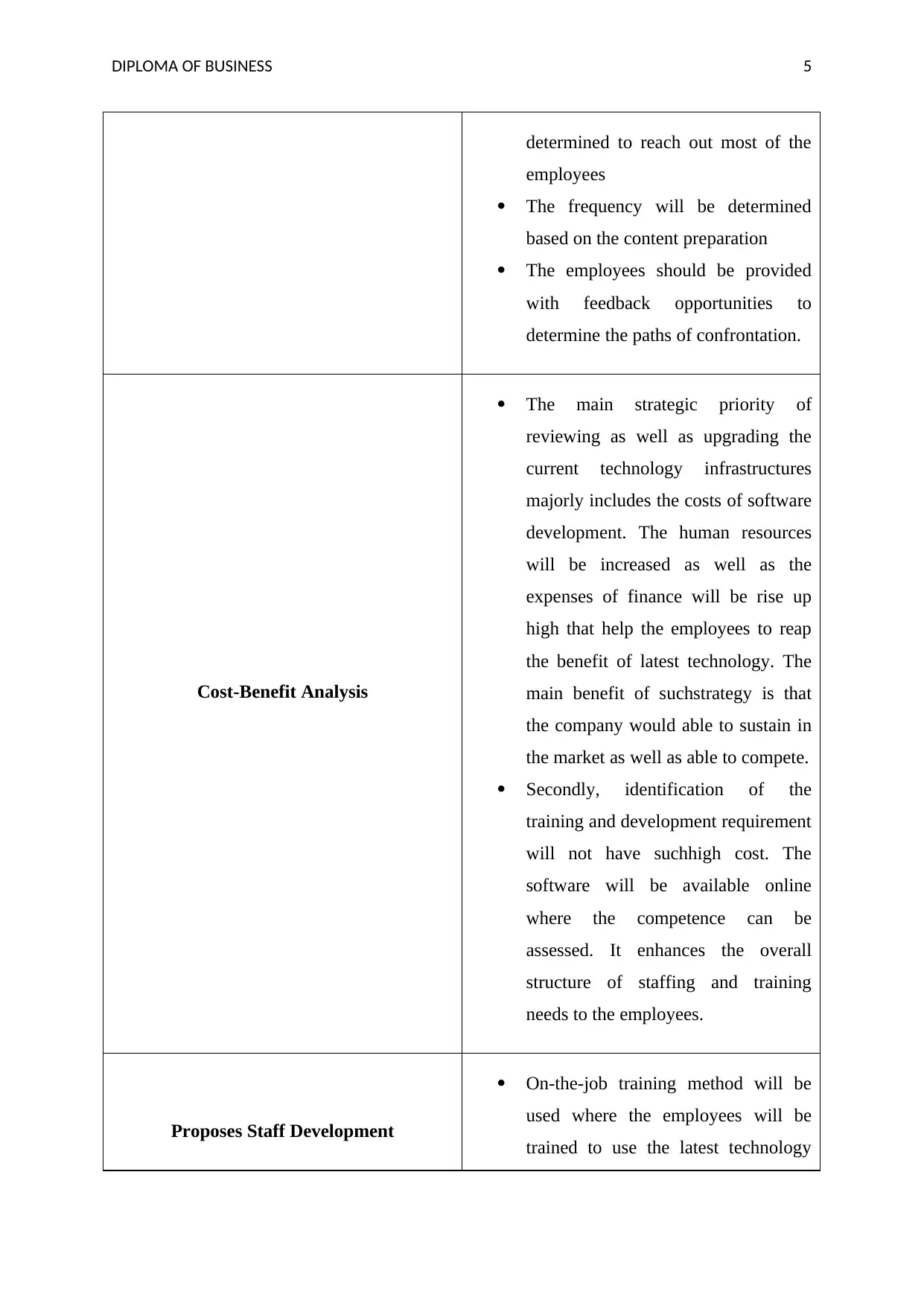
DIPLOMA OF BUSINESS 5
determined to reach out most of the
employees
The frequency will be determined
based on the content preparation
The employees should be provided
with feedback opportunities to
determine the paths of confrontation.
Cost-Benefit Analysis
The main strategic priority of
reviewing as well as upgrading the
current technology infrastructures
majorly includes the costs of software
development. The human resources
will be increased as well as the
expenses of finance will be rise up
high that help the employees to reap
the benefit of latest technology. The
main benefit of suchstrategy is that
the company would able to sustain in
the market as well as able to compete.
Secondly, identification of the
training and development requirement
will not have suchhigh cost. The
software will be available online
where the competence can be
assessed. It enhances the overall
structure of staffing and training
needs to the employees.
Proposes Staff Development
On-the-job training method will be
used where the employees will be
trained to use the latest technology
determined to reach out most of the
employees
The frequency will be determined
based on the content preparation
The employees should be provided
with feedback opportunities to
determine the paths of confrontation.
Cost-Benefit Analysis
The main strategic priority of
reviewing as well as upgrading the
current technology infrastructures
majorly includes the costs of software
development. The human resources
will be increased as well as the
expenses of finance will be rise up
high that help the employees to reap
the benefit of latest technology. The
main benefit of suchstrategy is that
the company would able to sustain in
the market as well as able to compete.
Secondly, identification of the
training and development requirement
will not have suchhigh cost. The
software will be available online
where the competence can be
assessed. It enhances the overall
structure of staffing and training
needs to the employees.
Proposes Staff Development
On-the-job training method will be
used where the employees will be
trained to use the latest technology
⊘ This is a preview!⊘
Do you want full access?
Subscribe today to unlock all pages.

Trusted by 1+ million students worldwide
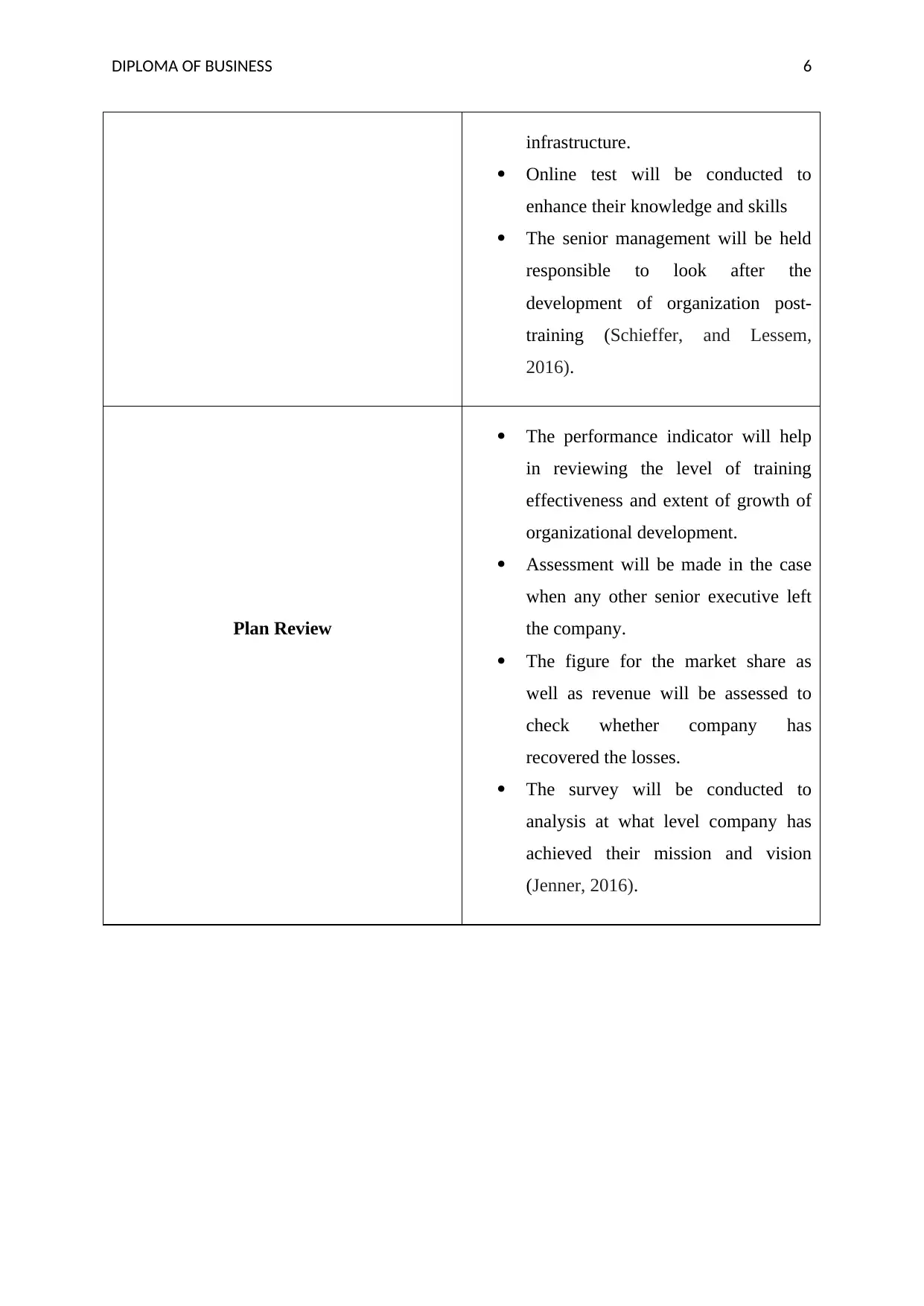
DIPLOMA OF BUSINESS 6
infrastructure.
Online test will be conducted to
enhance their knowledge and skills
The senior management will be held
responsible to look after the
development of organization post-
training (Schieffer, and Lessem,
2016).
Plan Review
The performance indicator will help
in reviewing the level of training
effectiveness and extent of growth of
organizational development.
Assessment will be made in the case
when any other senior executive left
the company.
The figure for the market share as
well as revenue will be assessed to
check whether company has
recovered the losses.
The survey will be conducted to
analysis at what level company has
achieved their mission and vision
(Jenner, 2016).
infrastructure.
Online test will be conducted to
enhance their knowledge and skills
The senior management will be held
responsible to look after the
development of organization post-
training (Schieffer, and Lessem,
2016).
Plan Review
The performance indicator will help
in reviewing the level of training
effectiveness and extent of growth of
organizational development.
Assessment will be made in the case
when any other senior executive left
the company.
The figure for the market share as
well as revenue will be assessed to
check whether company has
recovered the losses.
The survey will be conducted to
analysis at what level company has
achieved their mission and vision
(Jenner, 2016).
Paraphrase This Document
Need a fresh take? Get an instant paraphrase of this document with our AI Paraphraser
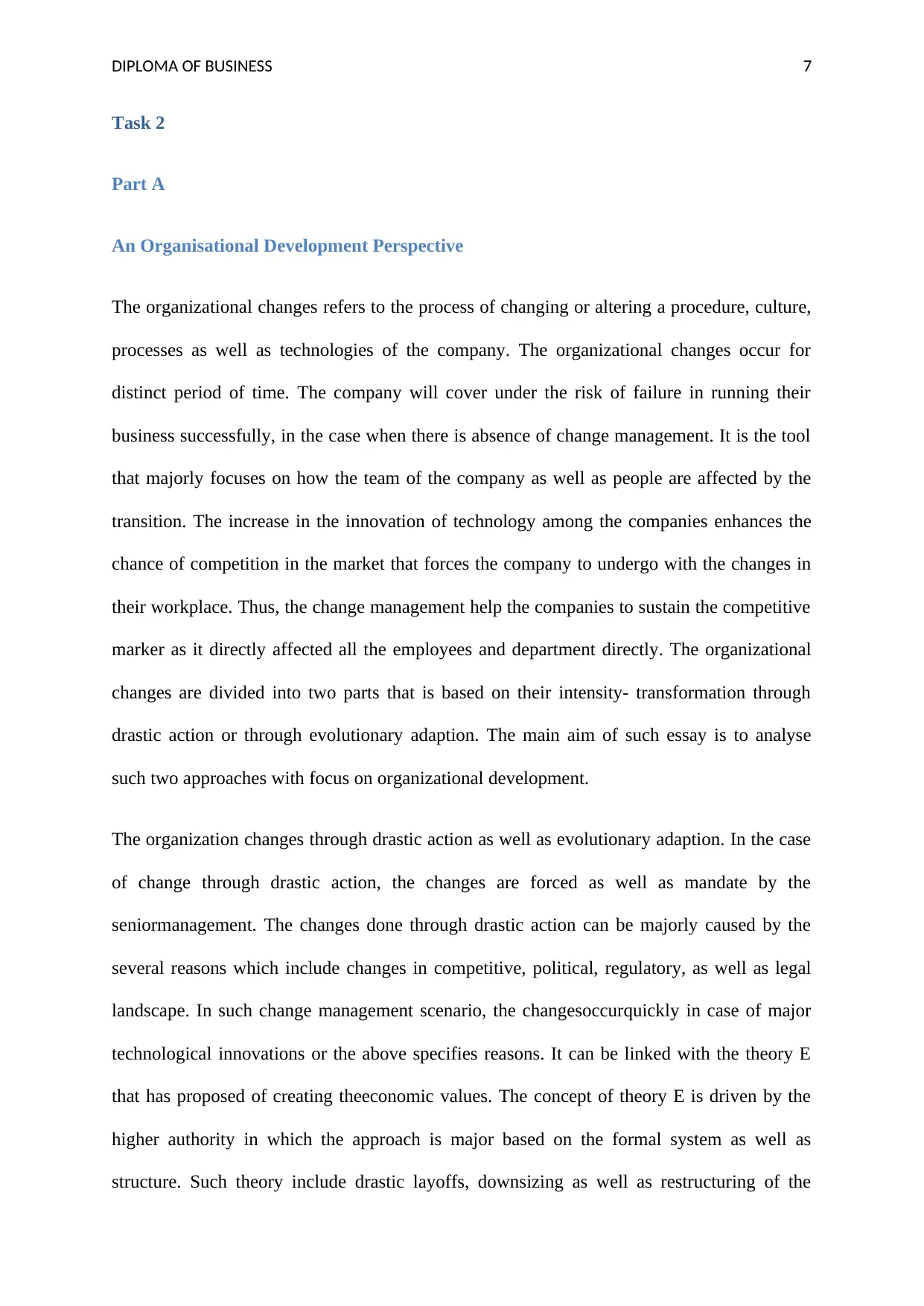
DIPLOMA OF BUSINESS 7
Task 2
Part A
An Organisational Development Perspective
The organizational changes refers to the process of changing or altering a procedure, culture,
processes as well as technologies of the company. The organizational changes occur for
distinct period of time. The company will cover under the risk of failure in running their
business successfully, in the case when there is absence of change management. It is the tool
that majorly focuses on how the team of the company as well as people are affected by the
transition. The increase in the innovation of technology among the companies enhances the
chance of competition in the market that forces the company to undergo with the changes in
their workplace. Thus, the change management help the companies to sustain the competitive
marker as it directly affected all the employees and department directly. The organizational
changes are divided into two parts that is based on their intensity- transformation through
drastic action or through evolutionary adaption. The main aim of such essay is to analyse
such two approaches with focus on organizational development.
The organization changes through drastic action as well as evolutionary adaption. In the case
of change through drastic action, the changes are forced as well as mandate by the
seniormanagement. The changes done through drastic action can be majorly caused by the
several reasons which include changes in competitive, political, regulatory, as well as legal
landscape. In such change management scenario, the changesoccurquickly in case of major
technological innovations or the above specifies reasons. It can be linked with the theory E
that has proposed of creating theeconomic values. The concept of theory E is driven by the
higher authority in which the approach is major based on the formal system as well as
structure. Such theory include drastic layoffs, downsizing as well as restructuring of the
Task 2
Part A
An Organisational Development Perspective
The organizational changes refers to the process of changing or altering a procedure, culture,
processes as well as technologies of the company. The organizational changes occur for
distinct period of time. The company will cover under the risk of failure in running their
business successfully, in the case when there is absence of change management. It is the tool
that majorly focuses on how the team of the company as well as people are affected by the
transition. The increase in the innovation of technology among the companies enhances the
chance of competition in the market that forces the company to undergo with the changes in
their workplace. Thus, the change management help the companies to sustain the competitive
marker as it directly affected all the employees and department directly. The organizational
changes are divided into two parts that is based on their intensity- transformation through
drastic action or through evolutionary adaption. The main aim of such essay is to analyse
such two approaches with focus on organizational development.
The organization changes through drastic action as well as evolutionary adaption. In the case
of change through drastic action, the changes are forced as well as mandate by the
seniormanagement. The changes done through drastic action can be majorly caused by the
several reasons which include changes in competitive, political, regulatory, as well as legal
landscape. In such change management scenario, the changesoccurquickly in case of major
technological innovations or the above specifies reasons. It can be linked with the theory E
that has proposed of creating theeconomic values. The concept of theory E is driven by the
higher authority in which the approach is major based on the formal system as well as
structure. Such theory include drastic layoffs, downsizing as well as restructuring of the
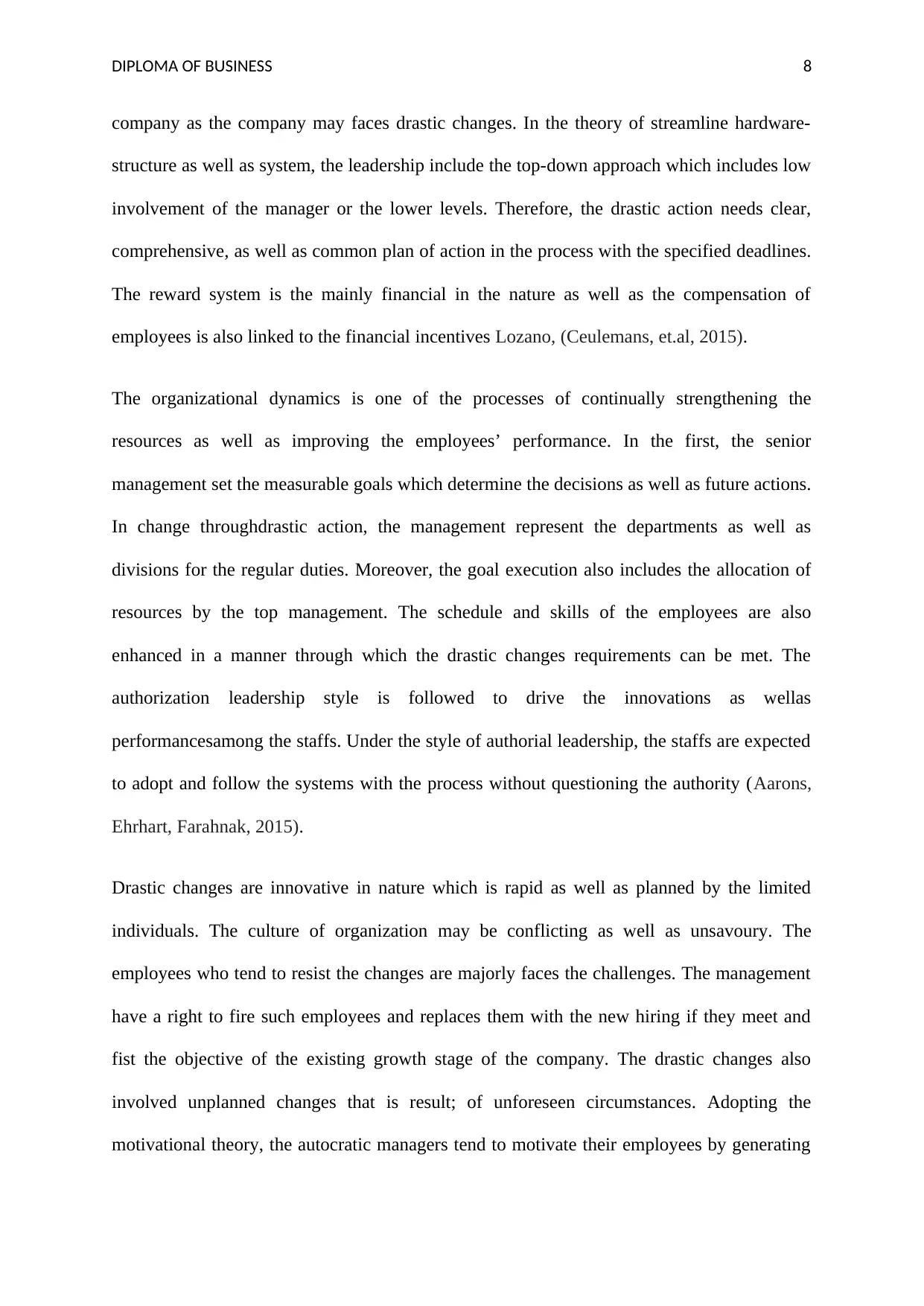
DIPLOMA OF BUSINESS 8
company as the company may faces drastic changes. In the theory of streamline hardware-
structure as well as system, the leadership include the top-down approach which includes low
involvement of the manager or the lower levels. Therefore, the drastic action needs clear,
comprehensive, as well as common plan of action in the process with the specified deadlines.
The reward system is the mainly financial in the nature as well as the compensation of
employees is also linked to the financial incentives Lozano, (Ceulemans, et.al, 2015).
The organizational dynamics is one of the processes of continually strengthening the
resources as well as improving the employees’ performance. In the first, the senior
management set the measurable goals which determine the decisions as well as future actions.
In change throughdrastic action, the management represent the departments as well as
divisions for the regular duties. Moreover, the goal execution also includes the allocation of
resources by the top management. The schedule and skills of the employees are also
enhanced in a manner through which the drastic changes requirements can be met. The
authorization leadership style is followed to drive the innovations as wellas
performancesamong the staffs. Under the style of authorial leadership, the staffs are expected
to adopt and follow the systems with the process without questioning the authority (Aarons,
Ehrhart, Farahnak, 2015).
Drastic changes are innovative in nature which is rapid as well as planned by the limited
individuals. The culture of organization may be conflicting as well as unsavoury. The
employees who tend to resist the changes are majorly faces the challenges. The management
have a right to fire such employees and replaces them with the new hiring if they meet and
fist the objective of the existing growth stage of the company. The drastic changes also
involved unplanned changes that is result; of unforeseen circumstances. Adopting the
motivational theory, the autocratic managers tend to motivate their employees by generating
company as the company may faces drastic changes. In the theory of streamline hardware-
structure as well as system, the leadership include the top-down approach which includes low
involvement of the manager or the lower levels. Therefore, the drastic action needs clear,
comprehensive, as well as common plan of action in the process with the specified deadlines.
The reward system is the mainly financial in the nature as well as the compensation of
employees is also linked to the financial incentives Lozano, (Ceulemans, et.al, 2015).
The organizational dynamics is one of the processes of continually strengthening the
resources as well as improving the employees’ performance. In the first, the senior
management set the measurable goals which determine the decisions as well as future actions.
In change throughdrastic action, the management represent the departments as well as
divisions for the regular duties. Moreover, the goal execution also includes the allocation of
resources by the top management. The schedule and skills of the employees are also
enhanced in a manner through which the drastic changes requirements can be met. The
authorization leadership style is followed to drive the innovations as wellas
performancesamong the staffs. Under the style of authorial leadership, the staffs are expected
to adopt and follow the systems with the process without questioning the authority (Aarons,
Ehrhart, Farahnak, 2015).
Drastic changes are innovative in nature which is rapid as well as planned by the limited
individuals. The culture of organization may be conflicting as well as unsavoury. The
employees who tend to resist the changes are majorly faces the challenges. The management
have a right to fire such employees and replaces them with the new hiring if they meet and
fist the objective of the existing growth stage of the company. The drastic changes also
involved unplanned changes that is result; of unforeseen circumstances. Adopting the
motivational theory, the autocratic managers tend to motivate their employees by generating
⊘ This is a preview!⊘
Do you want full access?
Subscribe today to unlock all pages.

Trusted by 1+ million students worldwide
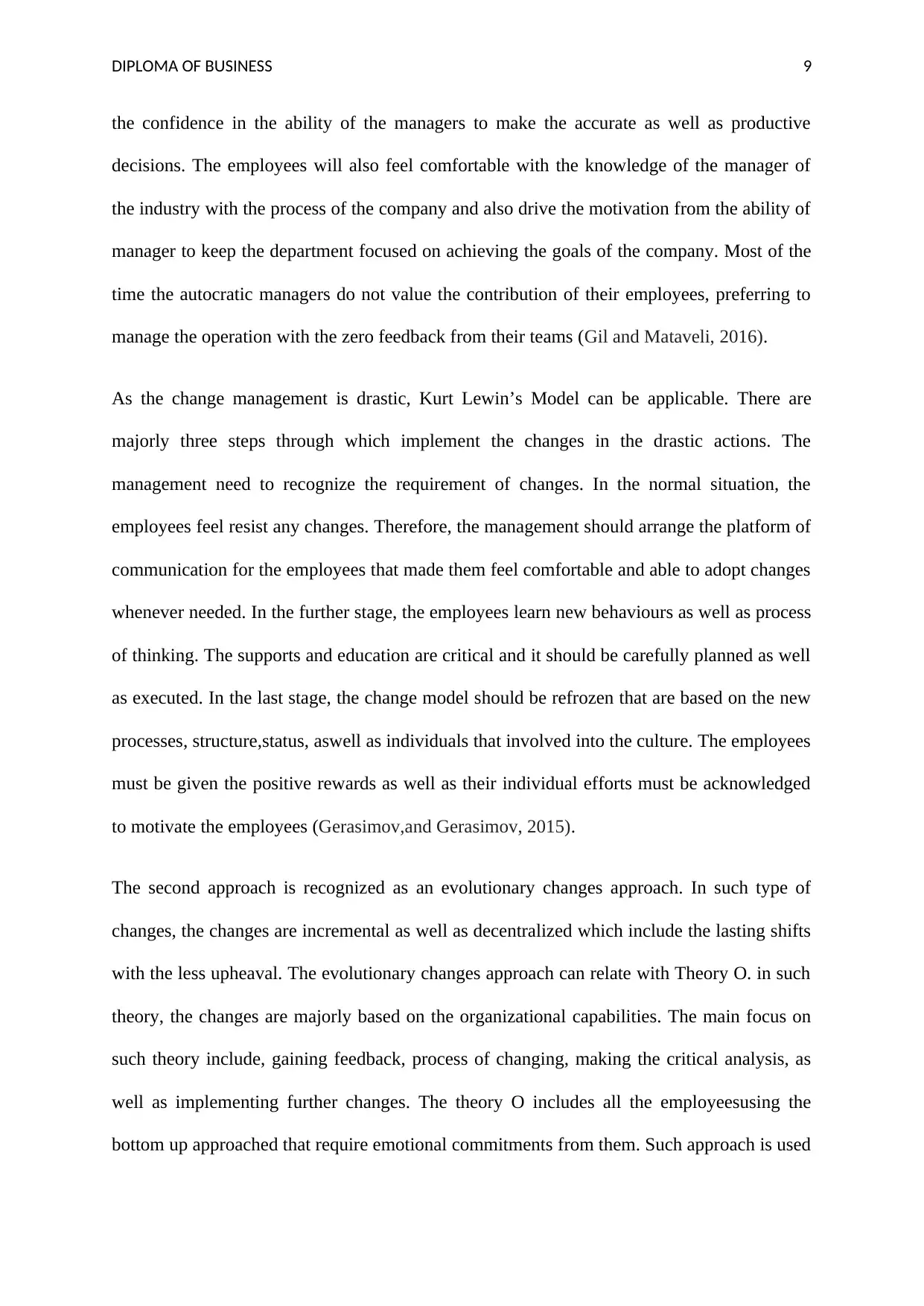
DIPLOMA OF BUSINESS 9
the confidence in the ability of the managers to make the accurate as well as productive
decisions. The employees will also feel comfortable with the knowledge of the manager of
the industry with the process of the company and also drive the motivation from the ability of
manager to keep the department focused on achieving the goals of the company. Most of the
time the autocratic managers do not value the contribution of their employees, preferring to
manage the operation with the zero feedback from their teams (Gil and Mataveli, 2016).
As the change management is drastic, Kurt Lewin’s Model can be applicable. There are
majorly three steps through which implement the changes in the drastic actions. The
management need to recognize the requirement of changes. In the normal situation, the
employees feel resist any changes. Therefore, the management should arrange the platform of
communication for the employees that made them feel comfortable and able to adopt changes
whenever needed. In the further stage, the employees learn new behaviours as well as process
of thinking. The supports and education are critical and it should be carefully planned as well
as executed. In the last stage, the change model should be refrozen that are based on the new
processes, structure,status, aswell as individuals that involved into the culture. The employees
must be given the positive rewards as well as their individual efforts must be acknowledged
to motivate the employees (Gerasimov,and Gerasimov, 2015).
The second approach is recognized as an evolutionary changes approach. In such type of
changes, the changes are incremental as well as decentralized which include the lasting shifts
with the less upheaval. The evolutionary changes approach can relate with Theory O. in such
theory, the changes are majorly based on the organizational capabilities. The main focus on
such theory include, gaining feedback, process of changing, making the critical analysis, as
well as implementing further changes. The theory O includes all the employeesusing the
bottom up approached that require emotional commitments from them. Such approach is used
the confidence in the ability of the managers to make the accurate as well as productive
decisions. The employees will also feel comfortable with the knowledge of the manager of
the industry with the process of the company and also drive the motivation from the ability of
manager to keep the department focused on achieving the goals of the company. Most of the
time the autocratic managers do not value the contribution of their employees, preferring to
manage the operation with the zero feedback from their teams (Gil and Mataveli, 2016).
As the change management is drastic, Kurt Lewin’s Model can be applicable. There are
majorly three steps through which implement the changes in the drastic actions. The
management need to recognize the requirement of changes. In the normal situation, the
employees feel resist any changes. Therefore, the management should arrange the platform of
communication for the employees that made them feel comfortable and able to adopt changes
whenever needed. In the further stage, the employees learn new behaviours as well as process
of thinking. The supports and education are critical and it should be carefully planned as well
as executed. In the last stage, the change model should be refrozen that are based on the new
processes, structure,status, aswell as individuals that involved into the culture. The employees
must be given the positive rewards as well as their individual efforts must be acknowledged
to motivate the employees (Gerasimov,and Gerasimov, 2015).
The second approach is recognized as an evolutionary changes approach. In such type of
changes, the changes are incremental as well as decentralized which include the lasting shifts
with the less upheaval. The evolutionary changes approach can relate with Theory O. in such
theory, the changes are majorly based on the organizational capabilities. The main focus on
such theory include, gaining feedback, process of changing, making the critical analysis, as
well as implementing further changes. The theory O includes all the employeesusing the
bottom up approached that require emotional commitments from them. Such approach is used
Paraphrase This Document
Need a fresh take? Get an instant paraphrase of this document with our AI Paraphraser
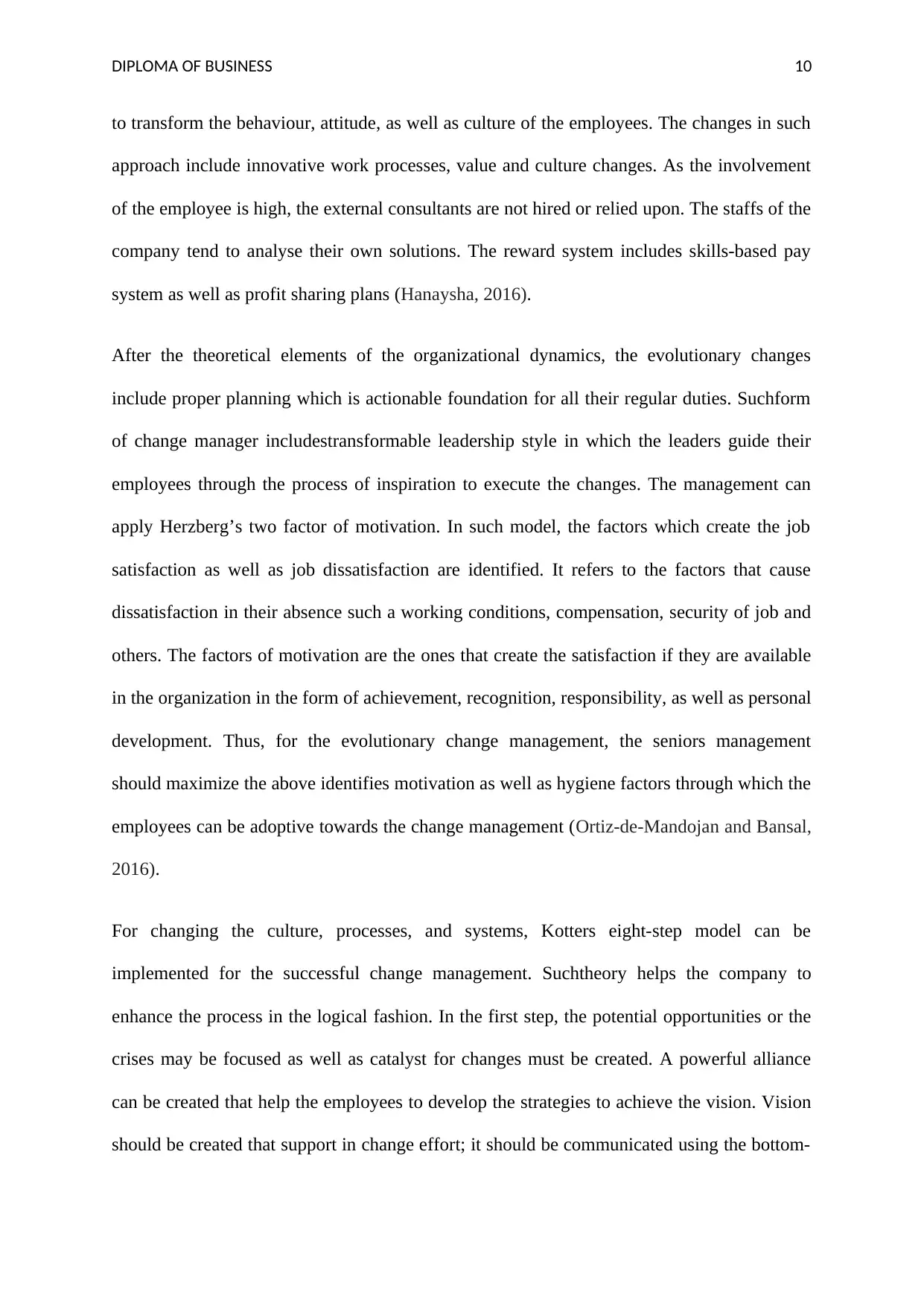
DIPLOMA OF BUSINESS 10
to transform the behaviour, attitude, as well as culture of the employees. The changes in such
approach include innovative work processes, value and culture changes. As the involvement
of the employee is high, the external consultants are not hired or relied upon. The staffs of the
company tend to analyse their own solutions. The reward system includes skills-based pay
system as well as profit sharing plans (Hanaysha, 2016).
After the theoretical elements of the organizational dynamics, the evolutionary changes
include proper planning which is actionable foundation for all their regular duties. Suchform
of change manager includestransformable leadership style in which the leaders guide their
employees through the process of inspiration to execute the changes. The management can
apply Herzberg’s two factor of motivation. In such model, the factors which create the job
satisfaction as well as job dissatisfaction are identified. It refers to the factors that cause
dissatisfaction in their absence such a working conditions, compensation, security of job and
others. The factors of motivation are the ones that create the satisfaction if they are available
in the organization in the form of achievement, recognition, responsibility, as well as personal
development. Thus, for the evolutionary change management, the seniors management
should maximize the above identifies motivation as well as hygiene factors through which the
employees can be adoptive towards the change management (Ortiz‐de‐Mandojan and Bansal,
2016).
For changing the culture, processes, and systems, Kotters eight-step model can be
implemented for the successful change management. Suchtheory helps the company to
enhance the process in the logical fashion. In the first step, the potential opportunities or the
crises may be focused as well as catalyst for changes must be created. A powerful alliance
can be created that help the employees to develop the strategies to achieve the vision. Vision
should be created that support in change effort; it should be communicated using the bottom-
to transform the behaviour, attitude, as well as culture of the employees. The changes in such
approach include innovative work processes, value and culture changes. As the involvement
of the employee is high, the external consultants are not hired or relied upon. The staffs of the
company tend to analyse their own solutions. The reward system includes skills-based pay
system as well as profit sharing plans (Hanaysha, 2016).
After the theoretical elements of the organizational dynamics, the evolutionary changes
include proper planning which is actionable foundation for all their regular duties. Suchform
of change manager includestransformable leadership style in which the leaders guide their
employees through the process of inspiration to execute the changes. The management can
apply Herzberg’s two factor of motivation. In such model, the factors which create the job
satisfaction as well as job dissatisfaction are identified. It refers to the factors that cause
dissatisfaction in their absence such a working conditions, compensation, security of job and
others. The factors of motivation are the ones that create the satisfaction if they are available
in the organization in the form of achievement, recognition, responsibility, as well as personal
development. Thus, for the evolutionary change management, the seniors management
should maximize the above identifies motivation as well as hygiene factors through which the
employees can be adoptive towards the change management (Ortiz‐de‐Mandojan and Bansal,
2016).
For changing the culture, processes, and systems, Kotters eight-step model can be
implemented for the successful change management. Suchtheory helps the company to
enhance the process in the logical fashion. In the first step, the potential opportunities or the
crises may be focused as well as catalyst for changes must be created. A powerful alliance
can be created that help the employees to develop the strategies to achieve the vision. Vision
should be created that support in change effort; it should be communicated using the bottom-
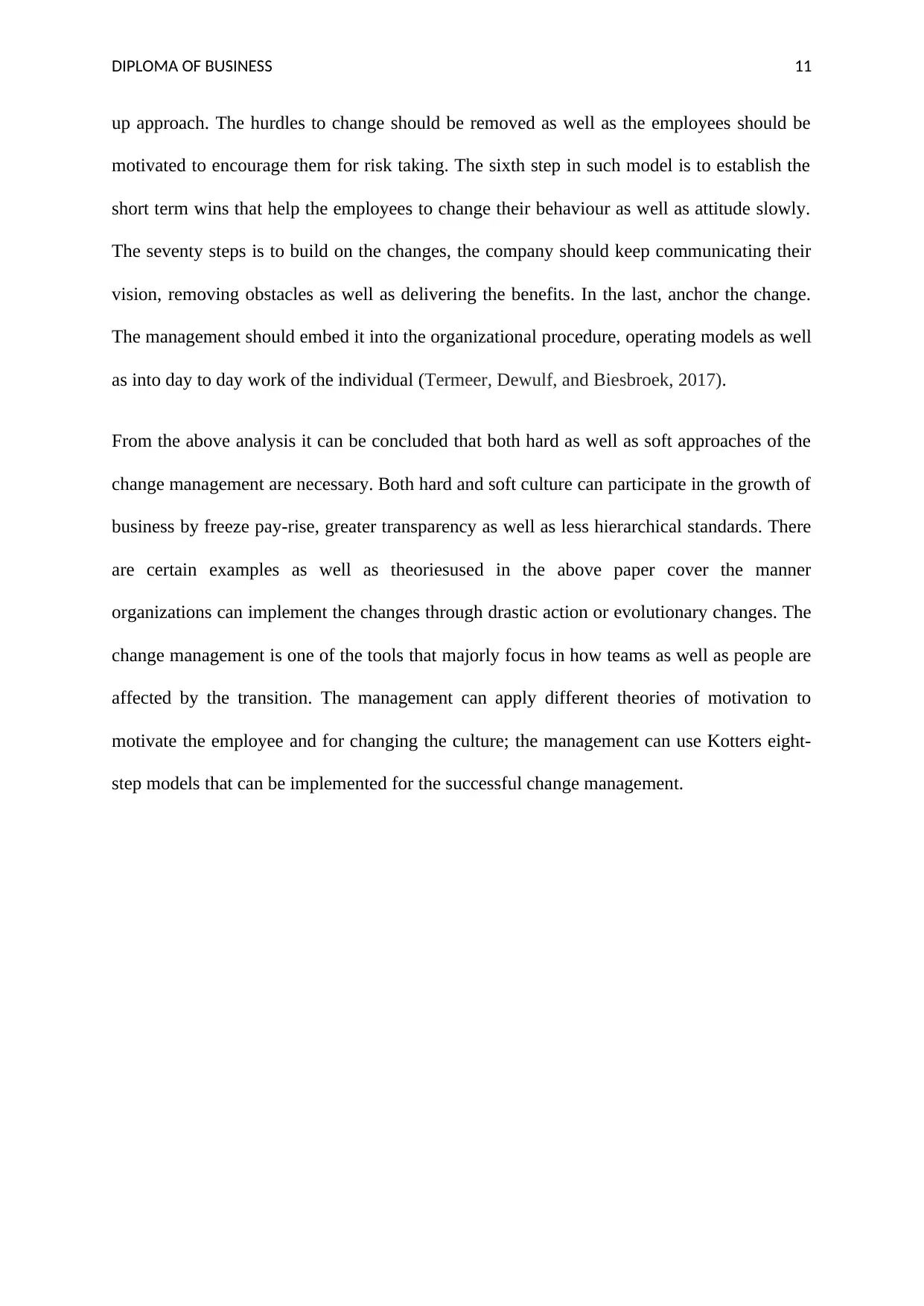
DIPLOMA OF BUSINESS 11
up approach. The hurdles to change should be removed as well as the employees should be
motivated to encourage them for risk taking. The sixth step in such model is to establish the
short term wins that help the employees to change their behaviour as well as attitude slowly.
The seventy steps is to build on the changes, the company should keep communicating their
vision, removing obstacles as well as delivering the benefits. In the last, anchor the change.
The management should embed it into the organizational procedure, operating models as well
as into day to day work of the individual (Termeer, Dewulf, and Biesbroek, 2017).
From the above analysis it can be concluded that both hard as well as soft approaches of the
change management are necessary. Both hard and soft culture can participate in the growth of
business by freeze pay-rise, greater transparency as well as less hierarchical standards. There
are certain examples as well as theoriesused in the above paper cover the manner
organizations can implement the changes through drastic action or evolutionary changes. The
change management is one of the tools that majorly focus in how teams as well as people are
affected by the transition. The management can apply different theories of motivation to
motivate the employee and for changing the culture; the management can use Kotters eight-
step models that can be implemented for the successful change management.
up approach. The hurdles to change should be removed as well as the employees should be
motivated to encourage them for risk taking. The sixth step in such model is to establish the
short term wins that help the employees to change their behaviour as well as attitude slowly.
The seventy steps is to build on the changes, the company should keep communicating their
vision, removing obstacles as well as delivering the benefits. In the last, anchor the change.
The management should embed it into the organizational procedure, operating models as well
as into day to day work of the individual (Termeer, Dewulf, and Biesbroek, 2017).
From the above analysis it can be concluded that both hard as well as soft approaches of the
change management are necessary. Both hard and soft culture can participate in the growth of
business by freeze pay-rise, greater transparency as well as less hierarchical standards. There
are certain examples as well as theoriesused in the above paper cover the manner
organizations can implement the changes through drastic action or evolutionary changes. The
change management is one of the tools that majorly focus in how teams as well as people are
affected by the transition. The management can apply different theories of motivation to
motivate the employee and for changing the culture; the management can use Kotters eight-
step models that can be implemented for the successful change management.
⊘ This is a preview!⊘
Do you want full access?
Subscribe today to unlock all pages.

Trusted by 1+ million students worldwide
1 out of 19
Related Documents
Your All-in-One AI-Powered Toolkit for Academic Success.
+13062052269
info@desklib.com
Available 24*7 on WhatsApp / Email
![[object Object]](/_next/static/media/star-bottom.7253800d.svg)
Unlock your academic potential
Copyright © 2020–2025 A2Z Services. All Rights Reserved. Developed and managed by ZUCOL.





